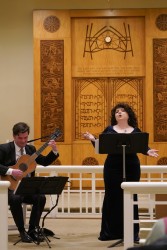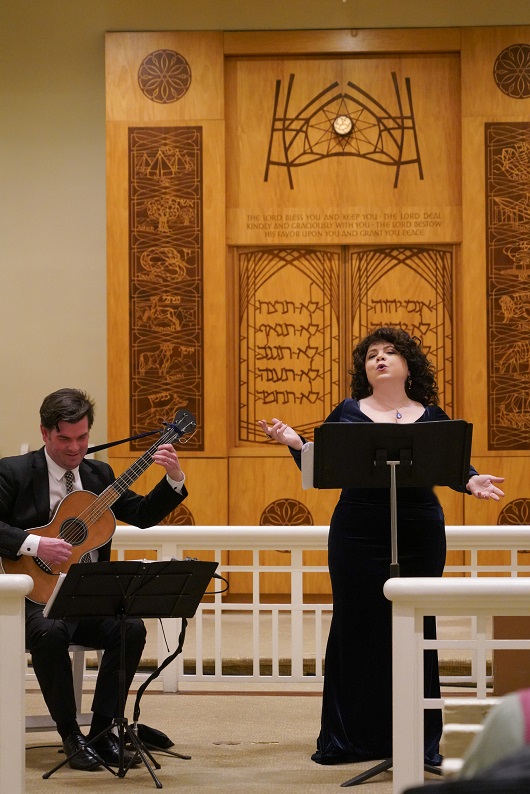 United States Various composers, In the Wake of the Marseillaise: Jessica Gould (soprano) Pascal Valois (early romantic guitar). The Brotherhood Synagogue, New York, 13.12.2018. (CP)
United States Various composers, In the Wake of the Marseillaise: Jessica Gould (soprano) Pascal Valois (early romantic guitar). The Brotherhood Synagogue, New York, 13.12.2018. (CP)

(c) Stephen Delas Heras
Jessica Gould’s and Pascal Valois’ concert of early romantic guitar-based song was a program of rarities and a performance to savor Thursday evening in the historic Brotherhood Synagogue on Gramercy Park. It would have been easy enough to present a concert of pretty music for voice and guitar in this stately 19th-century edifice that was once a stop on the Underground Railroad, and given the appeal of Valois’ playing and Gould’s voice, as well as the rarity of Valois’ 1820 instrument, that would have been sufficient for many.
But rather than an evening of look-at-me virtuosity, blandly pleasant music-making, or ‘how cool is my instrument’ early music buzz, Salon/Sanctuary Concerts, as usual, went the extra mile, presenting something that was a feat of both musical and curatorial skill, the kind of program that is so multi-layered and thought provoking that one remains in post-concert contemplation or heated conversation for hours afterward.
‘In the Wake of the Marseillaise: Songs of Love, Loss, and Triumph from the Age of Emancipation’ gave insight into how the end of the Ancien Régime in France and Napoleonic era of conquest and liberation throughout Europe wrought social change that was reflected in the musical culture of the early nineteenth century. The program, as wide ranging and eclectic as I have seen from this excellent series, hinted at the many strands that 19th-century music would evolve into, starting from these embryonic few decades at the beginning of the century.
Those of us who like a side of reading with our music have come to appreciate Gould’s informative and well-written program notes for her series’ historically grounded offerings. Especially valuable with this program of mostly unknown repertoire, her essay offered insights into the relatively brief vogue for these songs before this moment of voice accompanied by guitar was eclipsed by piano-based composition — though solo repertoire of guitar composition remained in wide practice. Also, she identifies the subtle but persistent influence of these composers on later generations of musicians.
As the title of the program suggests, she shares how Napoleonic reforms eliminated legal marginalization of Jews and allowed Jewish composers to participate in the musical culture of the time. Alas, just as the moment for these songs was limited, so was regard for Jewish artists of the period, as anti-Semitic prejudice reared its ugly head. Shortly after the Bourbon restoration in France led to a retrench of Napoleonic emancipatory reforms, Richard Wagner’s essay ‘On Jewishness in Music’ appeared, dismissing the work of Jewish composers such as Fromental Halévy and Felix Mendelssohn as inferior, to devastating effect.
A conventional programming approach to this subject would have been a field guide to French-Jewish nineteenth century opera composers. Fortunately, we were treated to something far more interesting, which was an evening of neglected gems that culminated in the one piece by a Jewish composer, the portentous aria ‘Il va venir’ from Halévy’s opera La Juive (The Jewess), a climactic and innovative work to which all the others on the program seemed to lead.
Little known repertoire in three languages, all originally intended for guitar, gave us a sense of the dizzying scope of vocal composition in the Napoleonic era during the ascendance of the bourgeoisie, from the compact Italian mini-operas packed into various Italian canzone, to the wistful torch-song like introspection of the French romance, to the pulsing rhythm and direct folk song appeal of the Spanish seguidilla – all treasures that were forgotten once Schubert arrived on the scene and the German lied achieved supremacy.
The ambitious program was, without question, demanding of an audience’s attention span. However, there was also a charming kid-in-a-candy-store quality to the enthusiasm with which all these pieces were shared, and audience enthusiasm, as far as I could gage, remained strong throughout. Nevertheless, one might see how an intermission might be warranted for future performances, and if further runs of this program (this evening was its virgin outing, I am told) will lead to an eventual performance from memory, which from my perspective, would be ideal.
The concert opened with four Italian songs that ranged both high and low, typical vocal warm ups, but also interesting for reasons of provenance. The first piece by Cimarosa opened the door out of the classical era and led to pieces by Crescentini, a castrato-composer of the time, and Carulli, one of the great guitar composers who also wrote for voice. It was an amusing bit of trivia to know that the two low-lying numbers were most probably written for Giuseppina Grassini, a celebrated contralto and mistress of both Bonaparte and the Duke of Wellington. The other Italian set on the program, the Sei Ariette by Puccini’s grandfather Domenico, were of interest historically, (I mean, does anyone even know that Puccini’s grandfather was a composer?) and showed the pair to great advantage in perhaps their tightest ensemble performance of the evening.
In the opening set, Gould used the higher pieces to rev up, and while one might have preferred an actual mezzo or contralto in the lower numbers, the dark-hued soprano dipped effectively into this territory with an appealing warmth in the basement of her range, particularly in the ‘Languir d’amore’ of Crescentini. A conversational naturalness in the French set of romances by Charles Doisy and others communicated the poetry with a touching immediacy, evoking a Piaf-like world weariness for ‘L’Amour’, a Doisy piece whose facile text seems to demand irony. Another Doisy piece, ‘L’amour chassé par l’hymen’, a simple strophic composition about lost love, was quite affecting.
Valois has been gaining increasing recognition on the international concert circuit, and New York early music fans may remember his New York recital as part of Salon/Sanctuary’s concert series France à Cordes earlier this year. In a conversation with me before that performance, he discussed his instrument and approach to playing it. Cannily selected and placed guitar solos by Paganini and Giuliani bridged the vocal sections very effectively, helping to prepare our ears for what we would hear next in this program of almost completely unknown music, while arrangements of themes from both Rossini’s Otello and the Halévy opera set a stage, as it were, for the arias that followed.
The Québecois Valois is an exceptionally fine soloist who plays with a romantic temperament, coaxing many colors from a small instrument and shaping his phrases with such skill that one hears a whole narrative in his wordless playing. He plays with dimension, passion, and elegance, and is a pleasure to hear in a world full of so many flawless but soulless technicians.
He and Gould were united in expression, which became particularly impressive in the last two pieces, both arrangements of opera arias, in which Valois appeared to conjure an orchestra to accompany Gould’s chameleonic vocalism. Bringing a multitude of sonic colors to the table, Gould was no less expressive, finding an innocent angelic timbre for Desdemona’s prayer, a direct vibrancy for the opening Italian numbers, and amusingly distinct character voices for one comic number by Fernando Sor that featured two minutes of a battle royale between mother and daughter.
Gould has gained recognition as a performer of seventeenth-century music through two well received recordings on the MV Cremona label, and her judiciously employed vibrato may not be to every opera fan’s taste. Without venturing into the Pandora’s Box otherwise known as the Vibrato Wars, it bears mentioning that a YouTube investigation of historical recordings will reveal the minimal vibrato of earlier divas from the dawn of the previous century. Overly fragrant vibrato has become, for many, the spilled ketchup of our time, a cover for musical imprecision, and a concession to the modern steroidal opera house of bloated proportions.
Gould’s approach to the operatic repertoire on this program was anchored in the drama of the texts and a keen sense of style and ornamentation, which, sustained by the natural beauty of her voice, enabled this highly dramatic repertoire to blossom in an intimate space. Negotiating both Rossini’s melismas and Halévy’s dramatic flashes with ease, I found her performance, particularly of Desdemona’s aria ‘Assisa a pié d’un salice’, deeply moving. Backed up by the majestic orchestra that emerged magically from Valois’ guitar, the duo made it easy to understand why, in these few Napoleonic decades, guitar arrangements were all the rage.
Chris Petitt
For more about Salon/Sanctuary Concerts click here.
